使用Trident Protect 為 OpenShift 容器平台中的容器應用程式提供資料保護
 建議變更
建議變更


參考文件的此部分提供了使用Trident保護建立容器應用程式的快照和備份的詳細資訊。 NetApp Trident Protect 提供進階應用程式資料管理功能,可增強由NetApp ONTAP儲存系統和NetApp Trident CSI 儲存設定器支援的有狀態 Kubernetes 應用程式的功能和可用性。 Trident Protect 會建立應用程式快照和備份,這意味著不僅建立持久磁碟區中的應用程式資料的快照和備份,還可以建立應用程式元資料的快照和備份。 Trident Protect 建立的快照和備份可以儲存在以下任何物件儲存中,並在稍後從中還原。
-
AWS S3
-
Azure Blob 儲存
-
Google 雲端儲存
-
Ontap S3
-
儲存網格
-
任何其他 S3 相容存儲
Trident Protect 使用基於角色的存取控制 (RBAC) 的 Kubernetes 模型。預設情況下, Trident Protect 提供一個名為 trident-protect 的單一系統命名空間及其關聯的預設服務帳戶。如果您的組織擁有許多使用者或特定的安全需求,您可以使用Trident Protect 的 RBAC 功能來更精細地控制對資源和命名空間的存取。
有關Trident Protect 中的 RBAC 的更多信息,請參閱"Trident保護文檔"

|
叢集管理員可以存取預設的 trident-protect 命名空間中的資源,也可以存取所有其他命名空間中的資源。使用者無法在 trident-protect 命名空間中建立應用程式資料管理自訂資源 (CR),如快照和備份 CR。作為最佳實踐,使用者需要在應用程式命名空間中建立這些 CR。 |
可依照文件中提供的說明安裝Trident Protect"這裡"本節將展示使用Trident Protect 對容器應用程式進行資料保護和復原應用程式的工作流程。1.快照建立(按需、按計畫)2.從快照恢復(恢復到相同和不同的命名空間)3.備份創建4.從備份還原
先決條件
在為應用程式建立快照和備份之前,必須在Trident Protect 中配置物件儲存來儲存快照和備份。這是使用儲存桶 CR 完成的。只有管理員可以建立儲存桶 CR 並對其進行配置。在Trident Protect 中,儲存桶 CR 稱為 AppVault。 AppVault 物件是儲存桶的聲明性 Kubernetes 工作流程表示。 AppVault CR 包含儲存桶在保護作業(例如備份、快照、復原作業和SnapMirror複製)中所使用的必要配置。
在此範例中,我們將展示如何使用ONTAP S3 作為物件儲存。以下是為ONTAP S3 建立 AppVault CR 的工作流程: 1.在ONTAP叢集中的 SVM 中建立 S3 物件儲存伺服器。2.在物件儲存伺服器中建立一個儲存桶。3.在 SVM 中建立 S3 使用者。將存取密鑰和密鑰保存在安全的地方。4.在 OpenShift 中,建立一個金鑰來儲存ONTAP S3 憑證。5.為ONTAP S3 建立 AppVault 對象
為ONTAP S3 設定Trident保護 AppVault
使用ONTAP S3 作為 AppVault 設定Trident Protect 的範例 yaml 檔案
# alias tp='tridentctl-protect'
appvault-secret.yaml
apiVersion: v1
stringData:
accessKeyID: "<access key id created for a user to access ONTAP S3 bucket>"
secretAccessKey: "corresponding Secret Access Key"
#data:
# base 64 encoded values
# accessKeyID: <base64 access key id created for a user to access ONTAP S3 bucket>
# secretAccessKey: <base 64 Secret Access Key>
kind: Secret
metadata:
name: appvault-secret
namespace: trident-protect
type: Opaque
appvault.yaml
apiVersion: protect.trident.netapp.io/v1
kind: AppVault
metadata:
name: ontap-s3-appvault
namespace: trident-protect
spec:
providerConfig:
azure:
accountName: ""
bucketName: ""
endpoint: ""
gcp:
bucketName: ""
projectID: ""
s3:
bucketName: <bucket-name for storing the snapshots and backups>
endpoint: <endpoint IP for S3>
secure: "false"
skipCertValidation: "true"
providerCredentials:
accessKeyID:
valueFromSecret:
key: accessKeyID
name: appvault-secret
secretAccessKey:
valueFromSecret:
key: secretAccessKey
name: appvault-secret
providerType: OntapS3
# oc create -f appvault-secret.yaml -n trident-protect
# oc create -f appvault.yaml -n trident-protect
用於安裝 postgresql 應用程式的範例 yaml 檔案
postgres.yaml
apiVersion: apps/v1
kind: Deployment
metadata:
name: postgres
spec:
replicas: 1
selector:
matchLabels:
app: postgres
template:
metadata:
labels:
app: postgres
spec:
containers:
- name: postgres
image: postgres:14
env:
- name: POSTGRES_USER
#value: "myuser"
value: "admin"
- name: POSTGRES_PASSWORD
#value: "mypassword"
value: "adminpass"
- name: POSTGRES_DB
value: "mydb"
- name: PGDATA
value: "/var/lib/postgresql/data/pgdata"
ports:
- containerPort: 5432
volumeMounts:
- name: postgres-storage
mountPath: /var/lib/postgresql/data
volumes:
- name: postgres-storage
persistentVolumeClaim:
claimName: postgres-pvc
---
apiVersion: v1
kind: PersistentVolumeClaim
metadata:
name: postgres-pvc
spec:
accessModes:
- ReadWriteOnce
resources:
requests:
storage: 5Gi
---
apiVersion: v1
kind: Service
metadata:
name: postgres
spec:
selector:
app: postgres
ports:
- protocol: TCP
port: 5432
targetPort: 5432
type: ClusterIP
Now create the Trident protect application CR for the postgres app. Include the objects in the namespace postgres and create it in the postgres namespace.
# tp create app postgres-app --namespaces postgres -n postgres
建立快照
建立按需快照
# tp create snapshot postgres-snap1 --app postgres-app --appvault ontap-s3-appvault -n postgres
Snapshot "postgres-snap1" created.
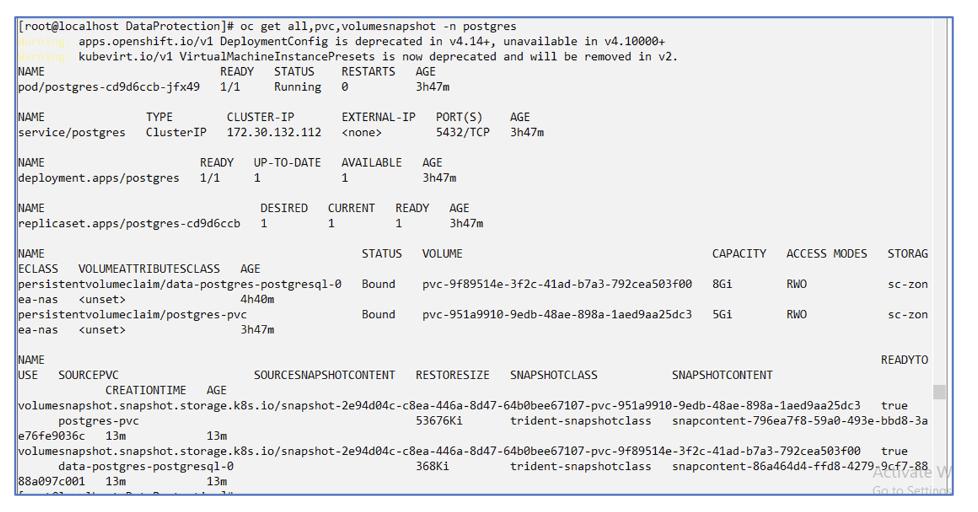
建立計畫 使用以下命令,將每天 15:33 建立快照,並保留兩個快照和備份。
# tp create schedule schedule1 --app postgres-app --appvault ontap-s3-appvault --backup-retention 2 --snapshot-retention 2 --granularity Daily --hour 15 --minute 33 --data-mover Restic -n postgres
Schedule "schedule1" created.
使用 yaml 建立計劃
# tp create schedule schedule2 --app postgres-app --appvault ontap-s3-appvault --backup-retention 2 --snapshot-retention 2 --granularity Daily --hour 15 --minute 33 --data-mover Restic -n postgres --dry-run > hourly-snapshotschedule.yaml
cat hourly-snapshotschedule.yaml
apiVersion: protect.trident.netapp.io/v1
kind: Schedule
metadata:
creationTimestamp: null
name: schedule2
namespace: postgres
spec:
appVaultRef: ontap-s3-appvault
applicationRef: postgres-app
backupRetention: "2"
dataMover: Restic
dayOfMonth: ""
dayOfWeek: ""
enabled: true
granularity: Hourly
#hour: "15"
minute: "33"
recurrenceRule: ""
snapshotRetention: "2"
status: {}
您可以看到按照此計劃建立的快照。

也創建了磁碟區快照。

刪除應用程式以模擬應用程式遺失
# oc delete deployment/postgres -n postgres
# oc get pod,pvc -n postgres
No resources found in postgres namespace.從快照還原到相同命名空間
# tp create sir postgres-sir --snapshot postgres/hourly-3f1ee-20250214183300 -n postgres
SnapshotInplaceRestore "postgres-sir" created.
應用程式及其 PVC 恢復到同一個命名空間。

從快照還原到不同的命名空間
# tp create snapshotrestore postgres-restore --snapshot postgres/hourly-3f1ee-20250214183300 --namespace-mapping postgres:postgres-restore -n postgres-restore
SnapshotRestore "postgres-restore" created.
您可以看到應用程式已還原到新的命名空間。

建立備份
建立按需備份
# tp create backup postgres-backup1 --app postgres-app --appvault ontap-s3-appvault -n postgres
Backup "postgres-backup1" created.
建立備份計畫
上面列表中的每日和每小時備份是根據先前設定的計劃建立的。
# tp create schedule schedule1 --app postgres-app --appvault ontap-s3-appvault --backup-retention 2 --snapshot-retention 2 --granularity Daily --hour 15 --minute 33 --data-mover Restic -n postgres
Schedule "schedule1" created.
從備份中恢復
刪除應用程式和 PVC 以模擬資料遺失。
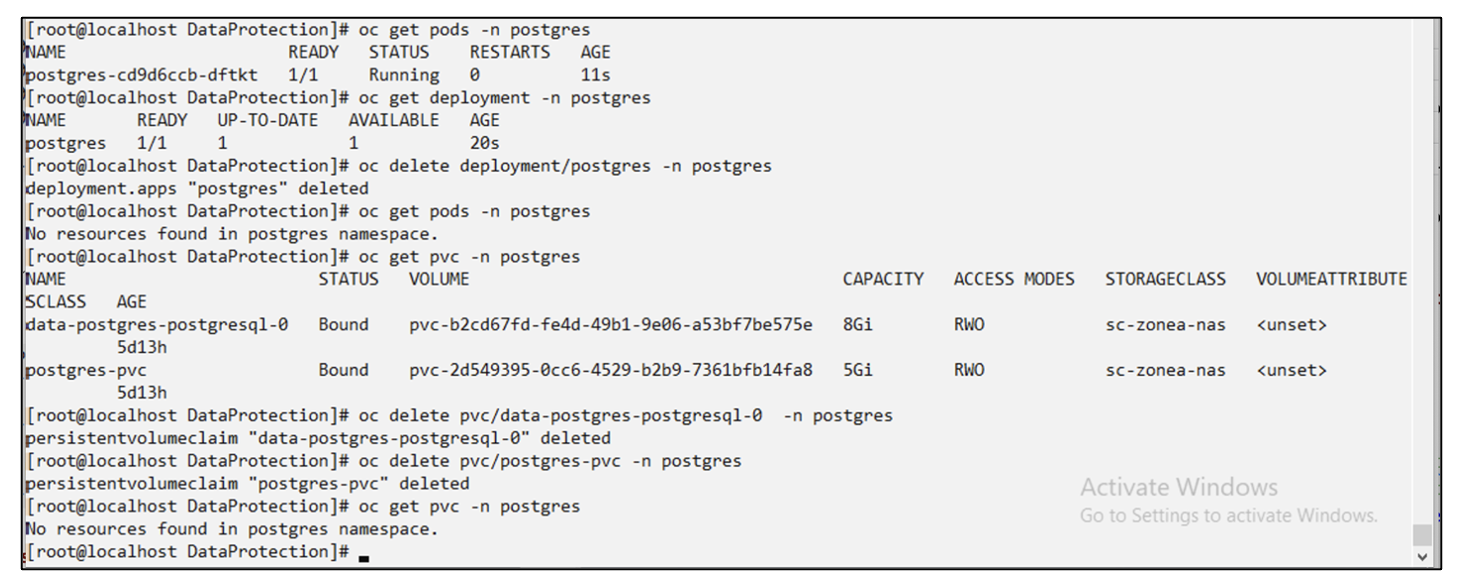
恢復到相同的命名空間 #tp create bir postgres-bir --backup postgres/hourly-3f1ee-20250224023300 -n postgres BackupInplaceRestore "postgres-bir" created。

應用程式和 PVC 在同一個命名空間中恢復。

恢復到不同的命名空間 建立一個新的命名空間。從備份還原到新的命名空間。
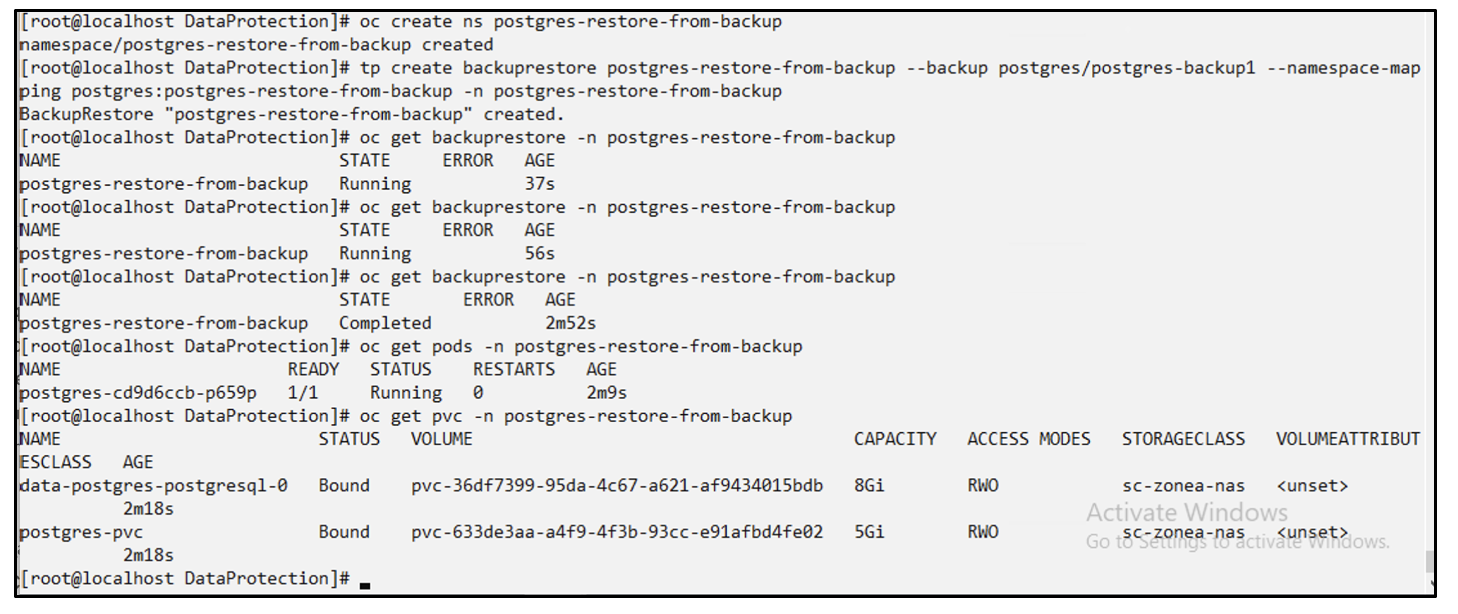
遷移應用程式
若要將應用程式複製或遷移到不同的叢集(執行跨叢集克隆),請在來源叢集上建立備份,然後將備份還原到不同的叢集。確保目標叢集上安裝了Trident保護。
在來源叢集上,執行下圖所示的步驟:
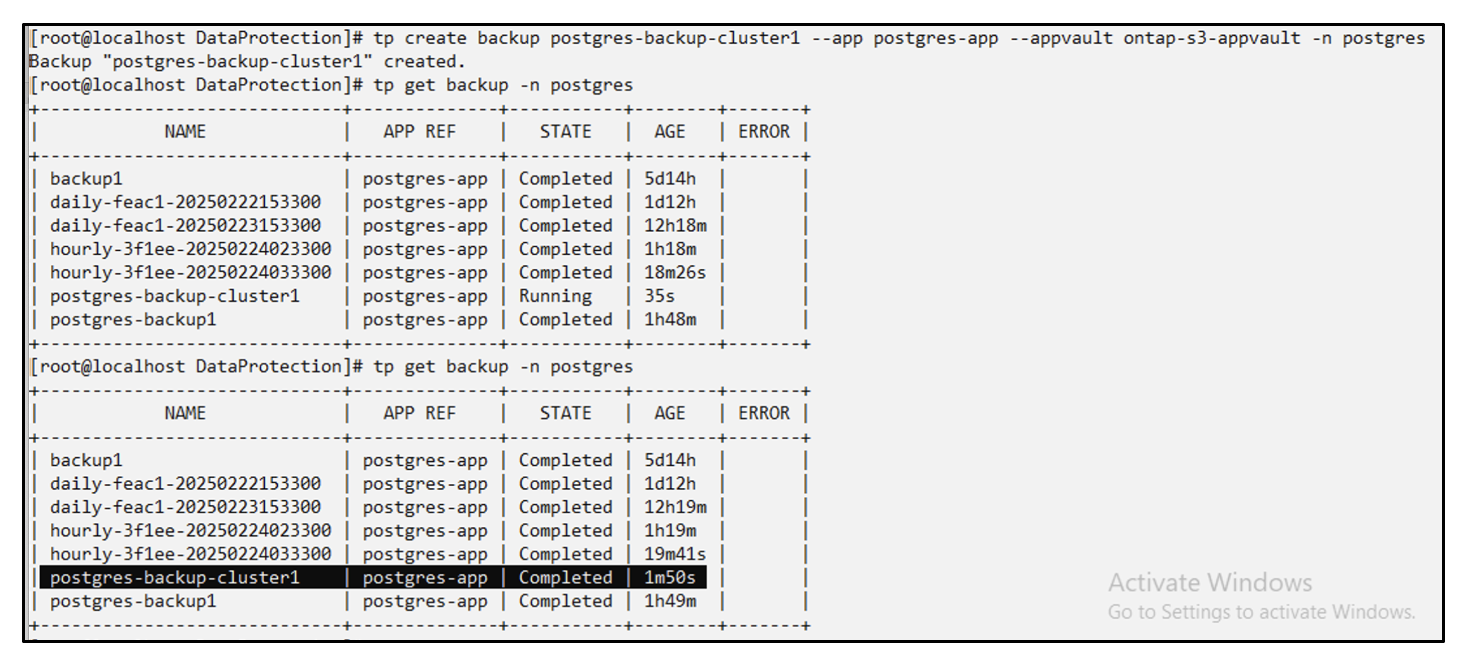
從來源集群,將上下文切換到目標集群。然後,確保可以從目標群集上下文存取 AppVault,並從目標群集取得 AppVault 內容。
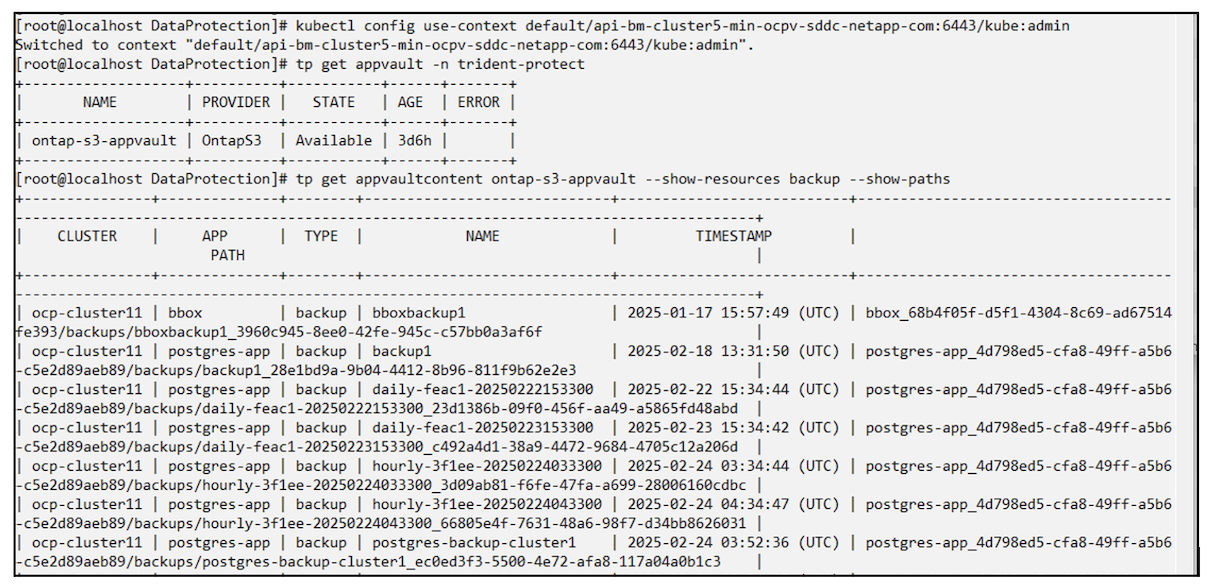
使用清單中的備份路徑並建立備份還原 CR 對象,如下面的命令所示。
# tp create backuprestore backup-restore-cluster2 --namespace-mapping postgres:postgres --appvault ontap-s3-appvault --path postgres-app_4d798ed5-cfa8-49ff-a5b6-c5e2d89aeb89/backups/postgres-backup-cluster1_ec0ed3f3-5500-4e72-afa8-117a04a0b1c3 -n postgres
BackupRestore "backup-restore-cluster2" created.
現在您可以看到應用程式 pod 和 PVC 已在目標叢集中建立。



